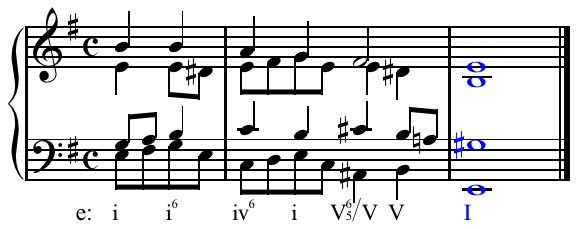 | ||
A Picardy third, Picardy cadence (/ˈpɪkərdi/) or, in French, tierce picarde is a major chord of the tonic at the end of a musical section that is either modal or in a minor key. This is achieved by raising the third of the expected minor triad by a semitone to create a major triad, as a form of resolution.
Contents
For example, instead of a cadence ending on an A minor chord containing the notes A, C, and E, a Picardy third ending would consist of an A major chord containing the notes A, C♯, and E. Note that the minor third between the A and C of the A minor chord has become a major third in the Picardy third chord.
Even in instrumental music, the picardy third retains its expressive quality: it is the "happy third". ... Since at least the beginning of the seventeenth century, it is no longer enough to describe it as a resolution to the more consonant triad; it is a resolution to the happier triad as well. ... The picardy third is absolute music's happy ending. Furthermore, I hypothesize that in gaining this expressive property of happiness or contentment, the picardy third augmented its power as the perfect, most stable cadential chord, being both the most emotionally consonant chord, so to speak, as well as the most musically consonant.
The Picardy third does not necessarily occur at the end of a section: it can be found at any perfect cadence or plagal cadence where the prevailing key is minor. As a harmonic device, the Picardy third originated in Western music in the Renaissance era.
What makes this a Picardy cadence is shown by the red natural sign. Instead of the expected B-flat (which would make the chord minor) the accidental gives us a B natural, making the chord major.
Listen to the final four measures of "I Heard the Voice of Jesus Say" with Play and without Play Picardy third (harmony by R. Vaughan Williams).
History
The origins of the term are obscure. An idea that was repeated as fact for some time, but turns out to have no provable basis, was that expounded by Jean-Jacques Rousseau in his Dictionnaire de Musique (1767): that this form of ending survived longest in church music, and due to the great number of cathedrals in the historical French province of Picardy. More plausible is the idea that the North of France, and Flanders, were influential in the development of contrapuntal music in the fifteenth century.
Robert Hall hypothesizes that, instead of deriving from the Picardy region of France, it comes from the Old French word "picart", meaning "pointed" or "sharp" in northern dialects, and thus refers to the musical sharp that transforms the minor third of the chord into a major third.
In medieval music, such as that of Machaut, neither major nor minor thirds were considered stable intervals, and so cadences were typically on open fifths. Examples of the Picardy third can be found throughout the works of J.S. Bach and his contemporaries, as well as earlier composers such as Thoinot Arbeau and John Blow.
This practice began to decline in the late sixteenth century and by the Classical era had been more or less discarded, although examples can be found in works by Haydn and Mozart. However, the switch from minor to major was a device frequently used to considerable expressive effect by Schubert. In "Gute Nacht", the strophic song that opens the song cycle Winterreise, Schubert changes from minor to major for the last verse.
In his book on the Winterreise, singer Ian Bostridge speaks of the "quintessentially Schubertian effect in the final verse, as the key shifts magically from minor to major". In the Romantic era, those of Chopin's nocturnes that are in a minor key almost always end with a Picardy third. A notable structural employment of this device occurs with the finale of the Tchaikovsky Fifth Symphony, where the motto theme makes its first appearance in the major mode.
Notably, J. S. Bach's two books of The Well-Tempered Clavier, composed in 1722 and 1744 respectively, differ considerably in their application of Picardy thirds, which occur unambiguously at the end of all of the minor-mode preludes and all but one of the minor-mode fugues in the first book. In the second book, however, fourteen of the minor-mode movements end on a minor chord, or occasionally, on a unison. Manuscripts vary in many of these cases.
Interpretation
According to James Bennighof: "Replacing an expected final minor chord with a major chord in this way is a centuries-old technique—the raised third of the chord, in this case G♯ rather than G natural, was first dubbed a 'Picardy third' ("tierce de Picarde") in print by Jean-Jacques Rousseau in 1797 ... to express [the idea that] hopefulness might seem unremarkable, or even clichéd."
